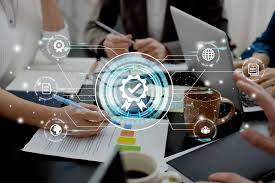In today’s fast-paced business environment, companies need efficient tools to streamline operations, improve productivity, and enhance decision-making. One such powerful tool is an Enterprise Resource Planning (ERP) system. ERP software integrates various business processes into a single unified system, helping organizations manage resources, automate workflows, and gain real-time insights.
If you’re looking to understand ERP systems in-depth, you’ve come to the right place. In this blog post, we’ll explore:
- What is an ERP System?
- Key Features of ERP Software
- Benefits of Implementing an ERP System
- Different Types of ERP Systems
- Steps to Successful ERP Implementation
- Common Challenges and How to Overcome Them
- Future Trends in ERP Technology
By the end of this guide, you’ll have a clear understanding of how ERP systems can transform your business operations.
1. What is an ERP System?
An Enterprise Resource Planning (ERP) system is a software platform that integrates core business functions such as finance, human resources, supply chain, manufacturing, sales, and customer relationship management (CRM) into a single system.
Why Do Businesses Need ERP?
- Eliminates Data Silos: Instead of using multiple disconnected systems, ERP centralizes data for better accuracy and accessibility.
- Improves Efficiency: Automates repetitive tasks, reducing manual errors and saving time.
- Enhances Decision-Making: Provides real-time analytics and reporting for informed business strategies.
ERP systems are used across industries, including manufacturing, healthcare, retail, education, and more.
2. Key Features of ERP Software
A robust ERP system comes with several essential features:
A. Financial Management
- Automated accounting, invoicing, and financial reporting.
- Budgeting, tax management, and compliance tracking.
B. Supply Chain Management (SCM)
- Inventory tracking, procurement, and order fulfillment.
- Supplier and vendor management.
C. Human Resource Management (HRM)
- Payroll processing, attendance tracking, and employee performance management.
- Recruitment and onboarding automation.
D. Customer Relationship Management (CRM)
- Sales tracking, lead management, and customer support.
- Marketing automation and customer analytics.
E. Business Intelligence & Reporting
- Customizable dashboards and KPI tracking.
- Predictive analytics and data-driven insights.
F. Mobile & Cloud Accessibility
- Remote access via cloud-based ERP solutions.
- Mobile apps for on-the-go management.
3. Benefits of Implementing an ERP System
A. Increased Operational Efficiency
- Reduces manual data entry and repetitive tasks.
- Streamlines workflows across departments.
B. Cost Savings
- Lowers operational costs by optimizing resources.
- Reduces inventory waste and overstocking.
C. Better Data Security & Compliance
- Role-based access control ensures data privacy.
- Helps meet industry regulations (GDPR, HIPAA, etc.).
D. Improved Collaboration
- Breaks down departmental silos for seamless communication.
- Real-time updates keep teams aligned.
E. Scalability & Growth
- Adapts to business expansion and changing needs.
- Supports multi-location and global operations.
4. Different Types of ERP Systems
Businesses can choose from various ERP solutions based on their needs:
A. On-Premise ERP
- Installed locally on company servers.
- Higher control but requires IT maintenance.
B. Cloud-Based ERP
- Hosted on vendor servers, accessible via the internet.
- Lower upfront costs and automatic updates.
C. Hybrid ERP
- Combines on-premise and cloud solutions.
- Offers flexibility for businesses transitioning to the cloud.
D. Industry-Specific ERP
- Tailored for sectors like healthcare, manufacturing, or retail.
- Includes specialized modules for niche requirements.
5. Steps to Successful ERP Implementation
Implementing an ERP system requires careful planning. Here’s a step-by-step guide:
Step 1: Define Business Goals
- Identify pain points and objectives (e.g., reducing costs, improving inventory management).
Step 2: Choose the Right ERP Vendor
- Compare features, pricing, and scalability (e.g., SAP, Oracle, Microsoft Dynamics).
Step 3: Plan the Implementation Process
- Set timelines, allocate budgets, and assign an ERP project team.
Step 4: Data Migration & System Configuration
- Transfer existing data securely and customize the ERP to fit business needs.
Step 5: Employee Training & Change Management
- Conduct training sessions to ensure smooth adoption.
Step 6: Go Live & Monitor Performance
- Launch the ERP system and track key metrics for optimization.
6. Common ERP Challenges & Solutions
Challenge 1: High Implementation Costs
- Solution: Opt for modular ERP deployment to spread costs over time.
Challenge 2: Employee Resistance
- Solution: Provide proper training and highlight ERP benefits.
Challenge 3: Data Migration Issues
- Solution: Cleanse data before migration and perform test runs.
Challenge 4: Integration with Legacy Systems
- Solution: Use APIs or middleware for seamless connectivity.
7. Future Trends in ERP Technology
The ERP landscape is evolving with new technologies:
- AI & Machine Learning: Predictive analytics and automated decision-making.
- IoT Integration: Real-time tracking of assets and inventory.
- Blockchain for Security: Enhanced data integrity and fraud prevention.
- Voice-Activated ERP: Hands-free control via virtual assistants.
Conclusion
ERP systems are no longer a luxury but a necessity for modern businesses. Whether you’re a small business or a large enterprise, implementing the right ERP solution can drive efficiency, reduce costs, and support growth.


















